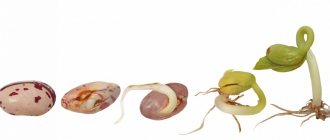Features of storing beans
First of all, it is recommended to choose the right container and storage space. Dry grains should be placed in a container that closes tightly. Glass jars are ideal for this. It is also acceptable to use plastic containers or bags. A dark and cool place is suitable for storing legumes. It is advisable that the temperature does not exceed +10 degrees. In this case, the humidity indicator should be 50%.
To protect the product from bugs, it should be placed in the freezer. In winter, it is permissible to move the beans to the balcony or take them out onto the terrace. Even with prolonged exposure to low temperatures, legumes retain their taste and beneficial elements.
When storing beans in a canvas bag, it is worth carrying out preparatory procedures. To do this, the grain should be placed in a saline solution and dried. This will help avoid the influence of bugs on the product.
Excellent options for storing product are pantries, sheds or cellars. In this case, maintaining a suitable temperature regime is of great importance. It is allowed to use a loggia or basement as temporary storage for beans.
It is worth considering that in such rooms it is difficult to maintain stable temperature and humidity.
Capsicum
Fresh green beans can be stored for no more than 2 days. This is due to rapid loss of moisture. In this case, it is better to put the beans in the refrigerator. It is recommended to pack the pods in plastic and place them in the vegetable compartment. In this case, the temperature should be +2 degrees, and humidity – 80-90%.
See also
How to preserve lemons for the winter at home, the best methods and timing
Asparagus
If the pods have already been picked, they should be immersed in boiling water for a minute, then transferred to the freezer and used as needed. Blanching avoids the transformation of sugar into starch. Thanks to this, the green beans will retain their delicate sweet taste.
Bean grain
This insect lives in beds, in places where beans are stored (for example, in warehouses), right in the green pods. For active life and reproduction of the pest, high humidity, food in the form of beans and a warm season are needed. The weevil penetrates the bean pod and lays about 30-50 larvae in it. After just a few weeks, the larvae grow and turn into adults. The female can lay eggs not only in the bean pod, but also inside the bean itself. This is where pests can come from in a hermetically sealed jar.
You need to get rid of bean grains at the planting stage. Before planting beans, the land is thoroughly treated with pesticides. Only perfectly even and completely intact bean grains should be allowed for planting. The weevil lays larvae inside the bean, under its thin film. If the larvae, along with an infected bean, fall into the ground, the entire harvest can be ruined.
Optimal storage conditions
To preserve beans for as long as possible, it is worth choosing the right conditions for this product.
Temperature
The duration of storage directly depends on the temperature. The optimal parameters are considered to be +5-10 degrees.
Humidity
To avoid the appearance of mold on the surface of the beans, the humidity should not exceed 50%. Otherwise, the product will lose its commercial qualities and acquire a bad smell.
Illumination
It is recommended to keep beans in a dry and dark place. It is best to put the product in a kitchen cabinet or pencil case. It should be located as far as possible from the stove.
Pest protection
To avoid damage to the beans by harmful insects, they should be placed in a glass container or textile bag. In addition to beans, it is worth putting some dill or garlic seeds in it.
Sprout fly
The sprout fly is gray in color with stripes on the back and measures about 5 mm in size. The fly's flight begins in the first half of May at air temperatures above +10 degrees. The first generation causes the greatest damage to the crop. The insect lays eggs in the soil, from which larvae emerge a week later and gnaw through the planted and swollen bean seeds.
To prevent the germ fly larvae from bothering you, you fight them:
- Beans are sown at air temperatures below +10 degrees.
- Prepare a repellent mixture and sprinkle the beds with bean crops, loosening the soil a little. The mixture consists of 200 g of ash. 1 tsp. tobacco dust, 1 tsp. hot pepper.
- The seedlings are watered with saturated salt solutions. 250 g of cooking layers are dissolved in 10 liters of water and watered the ground during the emergence of the larvae.
- The sprouts are watered with garlic infusion prepared from 400 g of ground garlic, infused in hot water (50-60 degrees) for 24 hours.
- If traditional methods do not help, to get rid of a harmful insect, use insecticides (preparations for controlling harmful insects, such as Decis, Fufanon). They can be used before the beans bloom.
How to prepare for storage
It is recommended to harvest beans in pods. In this form, it should be left to dry for 2 weeks. As a result, the pods will turn yellow and open a little, and the grains will acquire a firm consistency. The next step is to clean the beans from dry pods. After which it is recommended to bake them in an oven heated to 60 degrees. This must be done within half an hour. The beans should be placed on the baking sheet in 1 layer. This procedure will help deal with insect larvae.
It is important to consider that using such beans as planting material is prohibited.
If you plan to use legumes for planting, they should be placed in the freezer after harvesting. Thanks to this, it is possible to destroy pests and preserve germination.
See also
How to properly and for how long you can store jamon at home
Pest Control Measures
Most often, legumes are affected by the weevil beetle. This insect is capable of reproducing at high speed once it gets inside the pod. Even if one bean grain is damaged, pests can destroy the entire stock. Moreover, one legume can become a home for twenty larvae.
To store beans to prevent bugs from getting in, you need to adhere to the following recommendations. Or using additional processing before sending for storage.
- The weevil beetle runs without looking back from the smell of garlic and dill . With these spices, storing beans will be safe and will be successful in a cool pantry.
- The weevil beetle stops reproducing at low temperatures , and at -10°C it dies completely.
- Cold processing of beans most often occurs in the freezer. To do this, the legumes must be placed at a temperature of less than -10°C for up to 3 days.
- Calcination is carried out in the oven at a temperature of about 60°C for 20 - 30 minutes. In this case, the shell of the grains will become wrinkled, but the taste will remain the same. The bug cannot withstand heat treatment and dies, after which the beans are cooled and placed in storage containers with tight lids.
Winter storage methods
You can store beans in different ways. This allows each person to choose the best option.
In a canvas bag
The best way to store beans is to use a canvas bag. If the beans are properly prepared, the shelf life of the product is 2-3 years.
In an airtight glass container
It is permissible to keep beans in glass containers. It is important that it closes tightly. This storage method will help preserve the characteristics of the product for 4-6 years.
Carton boxes
Cardboard boxes are a good option for storing beans. To avoid active reproduction of bugs, it is permissible to use printing ink. To do this, the storage container should be covered with newspapers. It is important to take into account that this method is considered less reliable.
Wooden boxes
Wooden crates are an excellent option for preserving the characteristics of beans. At the same time, they should also be covered with newspapers. Thanks to this simple measure, it will be possible to avoid the active development of dangerous insects.
Warming up commercial grain
To avoid the spread of pests, it is recommended to heat the grains. This can be done in the oven. To carry out the procedure, place the beans on a baking sheet in 1 layer and place in an oven heated to 90 degrees. The duration of the procedure should be 3-5 minutes.
Once the beans have cooled, you can pour them into clean glass jars. It is recommended to seal the containers hermetically. To extend the shelf life, you should place a little garlic at the bottom of the dish. This will protect the beans from the development of parasites.
Canning
Canning is considered an excellent method for storing beans. To do this, you can use simple and accessible recipes. For 1 kilogram of beans it is worth taking 250 millimeters of sunflower oil. First, it is recommended to soak the beans for 12 hours. Then drain the water and boil the product until cooked. Chop the onion and carrots, simmer and add boiled beans. Simmer everything together for 10 minutes. Then you should add spices - salt, pepper, cloves. After 2 minutes, you can remove the workpiece from the stove. It needs to be poured into sterilized jars, rolled up, turned over and wrapped.
See also
TOP 6 ways to properly store marshmallows at home
There are bugs
If there are beetles in beans, you need to do the following:
- understand the scale of the disaster;
- if the damage is minor, sort through and remove visible pests;
- heat at 60 degrees for 1 hour in the oven or pour in a concentrated salt solution and boil;
- if all the fruits are damaged, it is better to throw them away;
- transfer to a small bag and freeze raw;
- Rinse under running water, cook and freeze the cooked beans in portions.
Beans are a tasty, healthy and nutritious vegetable that can replace meat in terms of protein content. To grow it, no special skills or knowledge are required. The main problem in preserving the crop is the correct methods of preparation for storage and preventive measures and cold storage. Then the percentage of losses will decrease significantly or will not exist at all.
Legumes occupy an important place in the human diet. Beans are used for preparing first courses and side dishes and are grown both on an industrial scale and in household plots. Perhaps this is the most popular type of legume in our country. Each owner tries to preserve his harvest and protect his crops from numerous pests and diseases. How can we make sure that the crop grows without problems and is stored for as long as possible? There are many ways to prevent beans from getting bugs.
Storage at room temperature and in glass jars
The grains can be stored at room temperature. The processing for this is more thorough and takes more time. Freeze the culture bag in the refrigerator for three hours. Next, remove the product from it and dry it.
Can be heated in the oven to 70ºС. Next, pack in bags or suitable containers. The lid must seal the container tightly. A dark, dry place is selected for storage.
In order to properly store beans in glass jars, it is important to prevent pests from outside that can reach the crop during the winter. If drying is not done properly, pests can attack all the seeds. Therefore, storage takes place in sealed packaging. Any plastic container or plastic bag will do the job. After drying, the prepared seeds should be poured into sealed packaging. A glass jar with a lid is the most suitable option. No pest will be able to get inside.
Advice.
For better preservation, it is preferable to use jars with a vacuum pump. After filling the container with beans, you can create a vacuum. This prevents the formation of bugs and fungus. The disadvantage of this operation is the inability to use seeds for planting.











